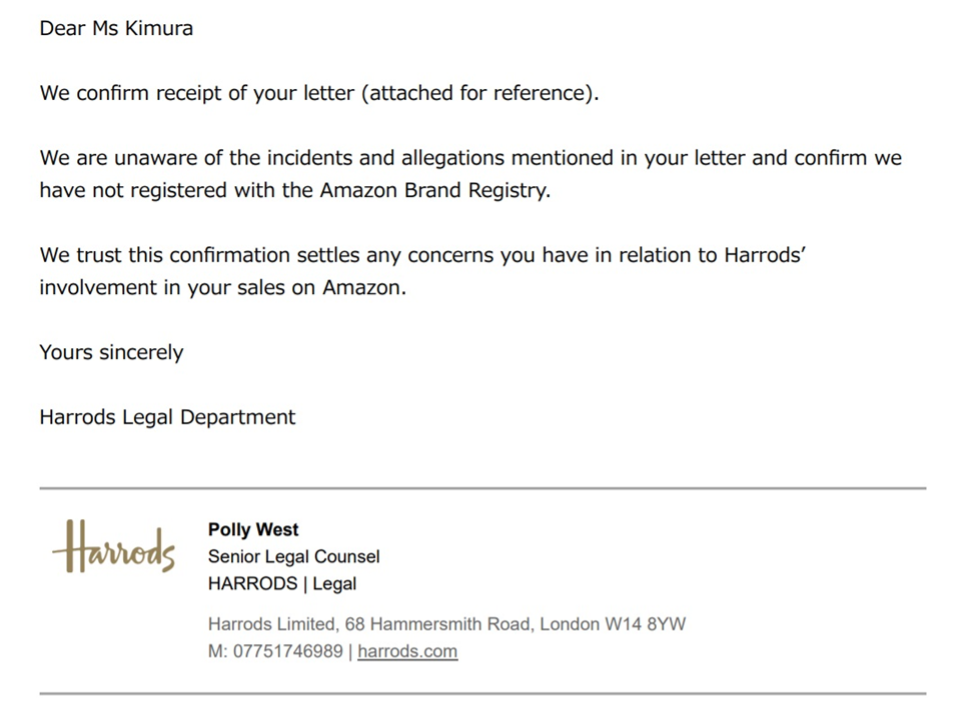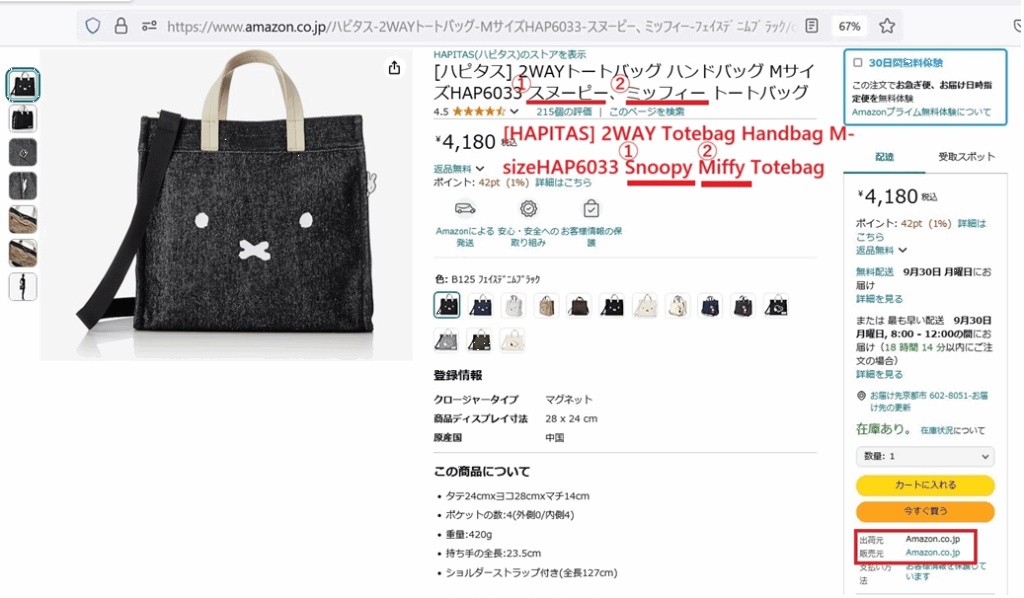Chapter 5 replies to the ‘matters for clarification’ requested by the Kyoto District Court, dated 20 November 2025.
1.When did the Professional Selling Plan contract with Amazon Japan start?
It started in June 2013.
2.Clarify the specific reasons and legal basis for the Claimant seeking a ‘court injunction against the use of a Brand Registry’.
Regarding brands against which the Claimant is alleged by Amazon to have committed intellectual property infringements, Amazon submitted, as Defendant’s Evidence 46 in this lawsuit, a list detailing whether these brands have actually been registered with the Amazon Brand Registry, and if they have, whether the Brand ID number has also been disclosed [Claimant Note: Amazon filed the Petition for Restriction on Inspection for Evidence 46 and this petition has been granted by the court]. In this evidence, the brand ‘Harrods’, relating to the Acts of torts claimed by Amazon in this lawsuit [Appendix 1-16 and 1-18], was listed as: ‘Registered with Amazon Brand Registry: Yes’. However, Amazon did not disclose the actual owner of the ‘Harrods’ brand.
The Claimant therefore submitted an enquiry to the legal department of Harrods, which is the rightful owner of the ‘Harrods’ trademark according to the information available on J-PlatPat (Japan Platform for Patent Information). This revealed that the rights owner of Harrods ‘has not been registered with the Amazon Brand Registry’. [Reference Material 5]
[Reference Material 5]Reply from Ms. Polly West, Senior Legal Counsel at Harrods Legal Department dated 4 December 2024

Regarding the brand ‘Miffy’, also relating to the Acts of torts claimed by Amazon in this lawsuit [Appendix 1-11], Mercis B.V., the rights owner of ‘Miffy’, informed the Claimant that they have never enforced any measure to restrict the sale of Miffy products on Amazon (Claimant Note: They were not aware of Miffy having been registered on the Amazon Brand Registry) and they even offered to contact Amazon on the Claimant’s behalf to ask them to allow her to sell Miffy merchandise that Amazon had previously removed. In their correspondence, Mercis B.V. pointed out that, contrary to the Claimant having been accused of an Intellectual Property infringement (Trademark violation: Miffy) by Amazon without any legal basis, it is Amazon that would possibly be committing a trademark violation as it is selling a ‘Miffy’ item, which has nothing to do with ‘Snoopy’, as a ‘Snoopy Miffy Tote Bag’ (Claimant’s Brief 26, p. 23).

Regarding legal inquiries to companies overseas, the Claimant used DHL, an international forwarder, as delivery is usually completed by the following Monday when a document is dispatched on a Friday and receipt can be proved with a photo of the recipient’s signature. The Claimant could have obtained the responses detailed earlier in this document using DHL’s signed delivery service; however, the delivery charge for this evidence alone would have been over 10,000 yen.
Nevertheless, it became obvious that either a third-party seller or Amazon themselves had violated the rights of the true trademark owner by registering the trademark without their knowledge. For instance, a seller on the Amazon Seller Forum commented that a third-party seller had already registered their trademark with the Amazon Brand Registry (Claimant’s Brief 20 pp. 20-24, Claimant’s Brief 22 p. 6).
Brands claim their rights officially by registering their own trademarks. Therefore, there is no reason to believe that their rights would be under threat if they do not do this secretly on Amazon. Thus, it is necessary to disclose which brands have been registered with whom. The current undisclosed ‘Brand Registry’ brings disbenefits to sellers who have not registered with the Brand Registry, including the Claimant (Claimant Note: Amazon permits trademark registered shops to register the names of their shops on the Brand Registry. These so-called Brand Registry sellers can then sell famous brands as a result of being exempted from intellectual property infringements as their Amazon registered brands are afforded priority over other brands). Unlike Amazon ‘brand registered’ shops who can sell anything under their own brand because they are protected by Amazon, non-brand registered shops are required by Amazon to purchase a substantial amount of goods from the proper rights owner when they want to list an item.
Moreover, at the time of registering items, Amazon states that the brand has a ‘brand owner’; therefore, if you want to use the brand name, you need permission from the brand owner registered on the Amazon Brand Registry. However, Amazon will never disclose who the brand owner is and even if it does, they may not necessarily be the true owner. Therefore, it is impossible to sell a genuine brand if the brand owner on the Amazon Brand Registry is an entity other than the brand. Furthermore, if the brands are overseas brands, it is troublesome for Japanese sellers to confirm whether the brand whose name they would like to use has in fact been registered on the Amazon Brand Registry, as the Claimant did, as this not only involves covering the cost of delivering the enquiry to the brand but also the necessity to prepare the document in English. Consequently, Amazon is running a system bringing disbenefits to Japanese sellers whose items then end up in unsellable stock, putting undue pressure on their businesses. [Reference 6] [Reference 6]
①Seller’s post on the Amazon Seller Forum on 22 November 2024


Evidence to show that other sellers have also had a problem with the system is provided by the following example submitted by a seller on the Amazon Seller Forum (see above for the original Japanese text):
Intellectual Property infringement (Trademark violation) claim by Amazon
The tradition of our company’s business has been to sell products using the fabrics of Harris Tweed made in the UK. A clear rule has officially been set by the brand for using this, which is that ‘Harris Tweed X’ can only be written on a product if more than 50% of its surface consists of Harris Tweed fabrics.
However, on 14 November, Amazon demanded that we remove the words ‘Harris Tweed’ because this constituted an Intellectual Property infringement (Trademark Violation), even though we have the official right to use the name of the brand.
Regarding this case, we appealed to Amazon by submitting the following documents.– Official document of rules for using Harris Tweed
– Collaboration contract with the Harris Tweed production factory
– Business transaction record
– Invoice
– Purchase contract (8 documents in total)Although we have been allowed to sell some ASIN (products) again during the course of the appeal, Amazon continued to demand that we remove other ASIN products or ‘submit official permission’. When we contacted Amazon’s support service, we received the following reply: ‘Judgements may differ as the person reviewing your appeal differs’.
We are quite confused by the way this has been handled as it seems there is no set judgement within Amazon. We feel that the documents we have submitted have either not been examined or not been evaluated properly. Currently, we have no way of dealing with the problem and are forced into a situation where we will eventually have to remove the brand name.
Pursuing the issue further, we sent an email to Jeff Bezos and received an autoreply informing us that the ‘Appeal should be done from your performance page’. However, our performance page shows only an ‘Edit’ button (Claimant Note: ‘Edit’ is for removing words) and not an ‘Appeal’ button. Could someone with similar experience please advise me on how to resolve this situation?
②Seller’s post on the Amazon Seller Forum on 25 December 2024

Another seller posted the following topic on the Amazon Seller Forum about the Brand Registry and asked for advice from other sellers (see above for the original Japanese text):
My account has been suspended
My account has been suspended. However, having checked further, this does not relate to any violation in particular.
I have submitted explanations on several occasions by adding documents, but have received no response.
What should I do with huge inventories?
I would like to sue Amazon. Would I be better off suing Amazon Japan?
Amazon runs a system specific to each country. For instance, Amazon ‘points’, which Amazon uses to encourage sellers to make a purchase, has been introduced to counter the competing platformer Rakuten. Hence, this ‘points’ service is available only in Japan. It is important to note here that the sale of parallel imported goods is permitted under Japanese Law. Therefore, in Amazon Japan, which displays the list of brands prohibited from being sold as parallel imported, there is no reason why owners on the Brand Registry cannot be disclosed in their system, even if this is only for Amazon Japan. The Claimant thus demands that Amazon disclose the names of brands and the owners registered on the Amazon Brand Registry.
By not disclosing the brands registered, Amazon permits cross-border sales from overseas brands in secrecy or allows exclusive sales to third-party sellers (including Amazon) other than trademark owners. Running an undisclosed Amazon Brand Registry means that Amazon is violating the following laws: Article 19 of the Antimonopoly Act which states that ‘An enterprise must not employ unfair trade practices’ and Article 2 Section 9 number V which describes such practices as follows: ‘engaging in any act specified in one of the following by making use of one’s superior bargaining position over the counterparty unjustly, in light of normal business practices: refusing to receive goods in transactions with the counterparty, causing the counterparty to take back such goods after receiving them from the counterparty, delaying payment to the counterparty or reducing the amount of payment, or otherwise establishing or changing trade terms or executing transactions in a way disadvantageous to the counterparty’ (c).
Read about this in more detail: PDF pp. 1-9





